Classic Spreads
Five tried-and-true decoy setups for ducks and geese
Five tried-and-true decoy setups for ducks and geese
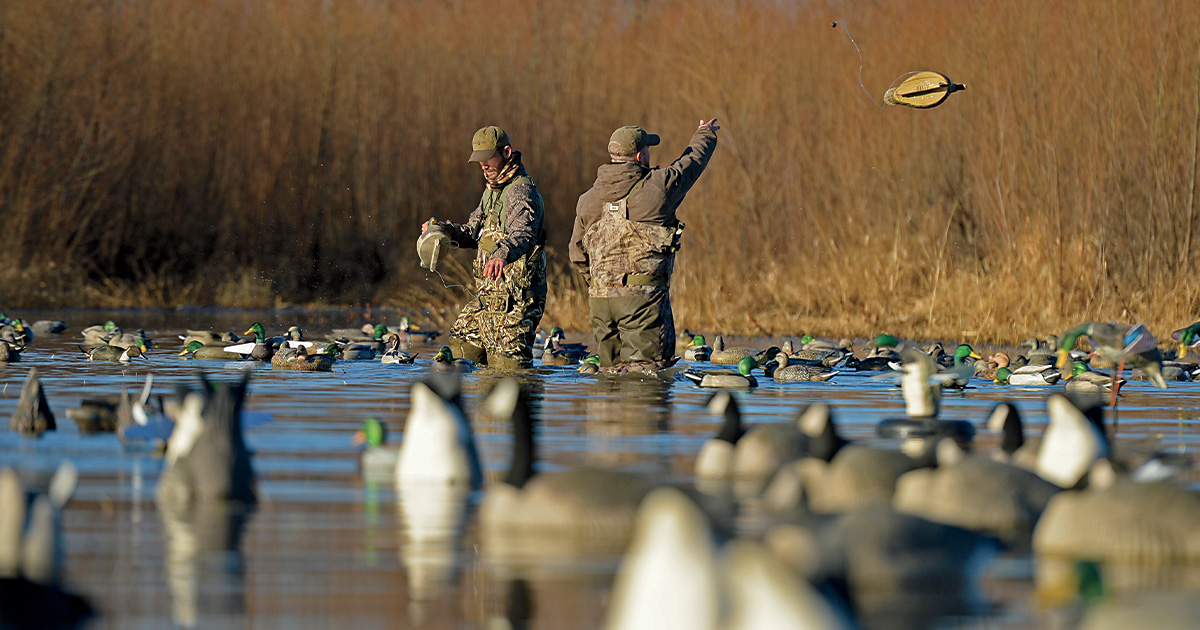
Innovation is at the heart of the modern waterfowl hunting experience. From shotshells to waders to the apps designed for watching weather and scouting for birds, new technologies continue to help hunters get the edge on ducks and geese. But when it comes to setting decoy spreads, “old school” often remains the rule because, as the saying goes, if something ain’t broke, don’t fix it.
There really is nothing new or flashy about these five decoy spreads, but generations of duck and goose hunters will tell you that they work. Try one or try them all this season, and you’ll find out why waterfowlers have been using them for years.
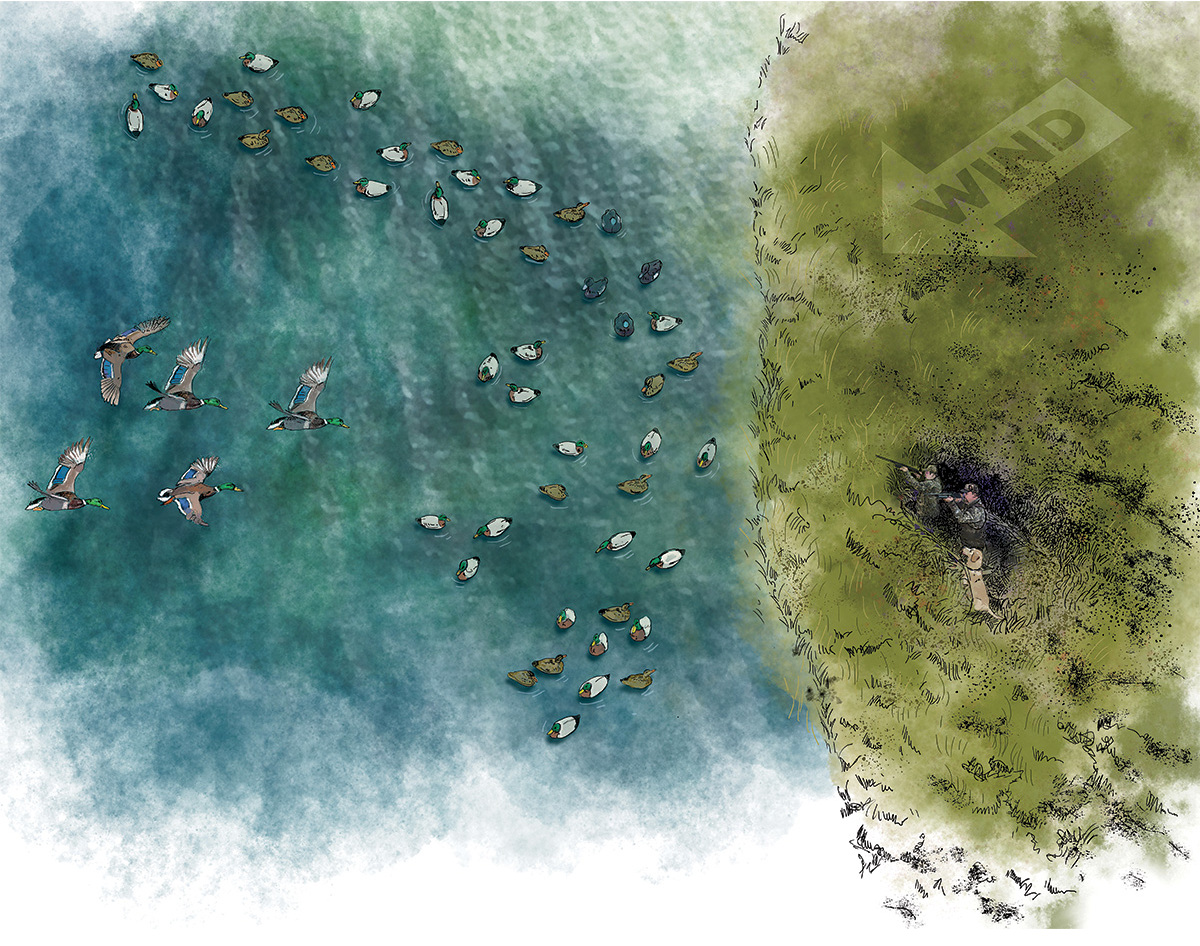
In this spread, as the name implies, decoys are placed in a J or fishhook pattern. The bulk of the decoys are on the upwind side of the spread, forming the bottom of the J, or the hook, in front of your blind. The long arm of the J extends downwind and acts as a runway for ducks making their final approach. Typically, birds will fly along the arm of the J and try to land in the hook, offering good shots. You can set up this spread with the sun behind you or to either side, creating shadows that will help keep you hidden from the watchful eyes of ducks flying overhead.
This versatile spread works well for puddle ducks and diving ducks. The number of decoys you’ll need can vary greatly and depends on a variety of factors. A large spread for a hunt over big water may include more than 100 decoys, while a downsized version for use on potholes and other small waters may include no more than a dozen.
“It really is a versatile spread that a hunter can use throughout the season and in many different locations,” says Drake Waterfowl pro staffer Barnie Calef. “I add Canada goose decoys on the upwind side when I’m targeting mallards. The ducks tend to work up and over the duck decoys, and then when they reach the Canada geese, they hit the brakes, drop their feet, and backpedal into the decoys. Honkers will decoy to this mixed spread of duck and goose decoys too, but it’s my go-to spread for greenheads.”
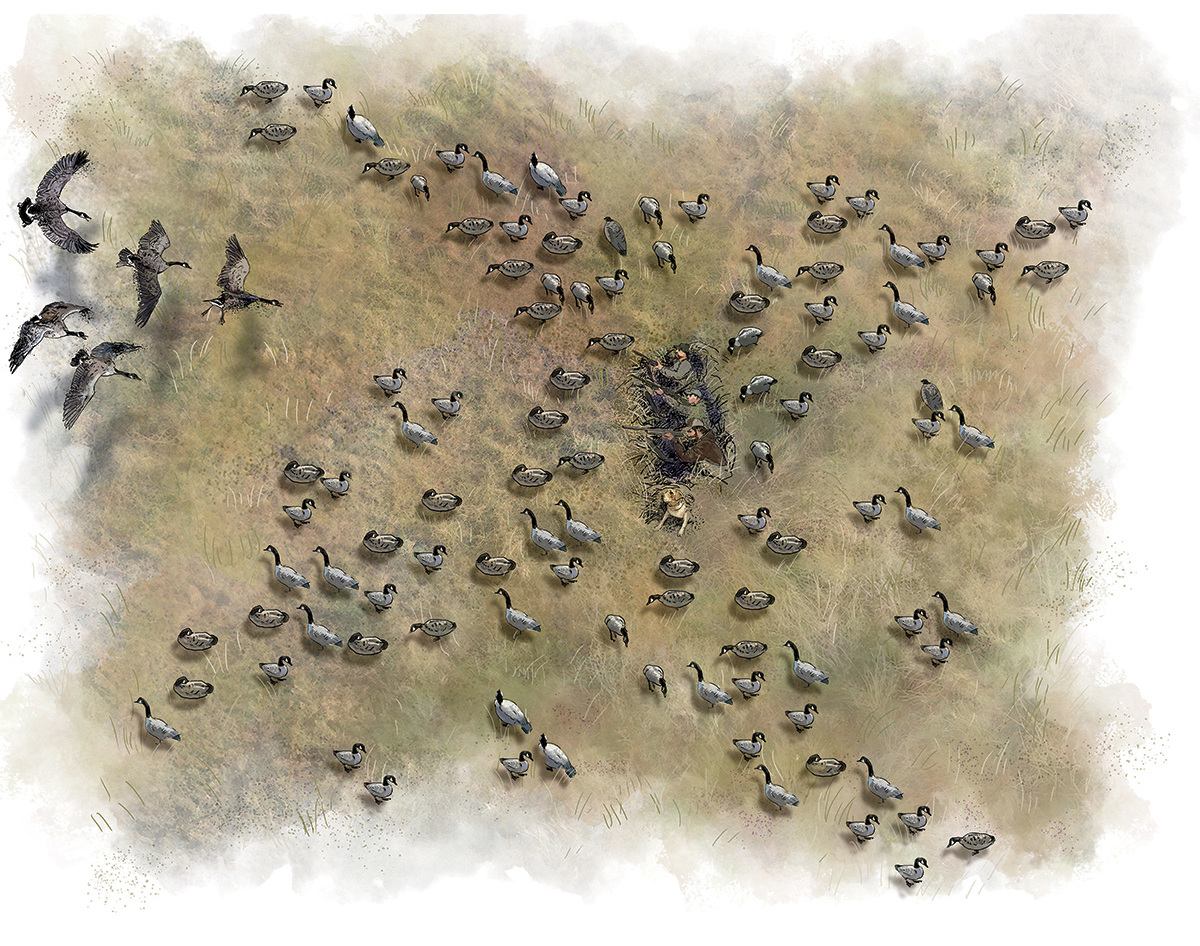
While the J decoy spread is designed to take advantage of the wind to put waterfowl directly in front and in range of hunters, the X is a decoy spread that many hunters turn to when the wind is light, variable, or not blowing at all.
Colorado guide and hunter Bill Schaefer often uses a variation of this spread while decoying Canada geese in harvested crop fields. He places groups of decoys to form a loose X pattern, with each arm extending 50 yards or more from the blind, which is located at the center of the spread. The objective is to create several pockets of space on different sides of the blind to give the geese the opportunity to land from various angles. Schaefer also places a heavier concentration of decoys around the blind to help conceal hunters and draw the attention of the birds. The number of decoys he uses varies, but X spreads tend to use more decoys than most other types of setups.
“Calling and flagging become really important with this setup, because that’s how you direct traffic and draw the geese in close enough for good shots,” Schaefer says. “I won’t call or flag much when the birds are flying above the blind, but I will be more aggressive when they are on the corners. It’s a bit of a cat-and-mouse game. I create just enough movement to keep them interested, but not so much that they can pick me out.”

For years, the decoy spread of choice for snow goose hunters has been the teardrop. “A teardrop shape, with the bulk of the decoys packed tightly around the blinds, near the crown of the spread, is a good setup for snow geese because it’s a pretty good representation of what they do on the ground,” explains veteran snow goose guide Charles Hamre. “Snow geese are voracious eaters, and they will feed very aggressively into the wind. New birds will always try to concentrate on the upwind side of a flock on the ground, because that’s where they stand a chance of getting at some food before the rest of the birds on the ground roll over it and gobble it up. Naturally, that upwind side is where hunters are going to want to be.”
Snow goose spreads tend to be large, and the teardrop pattern that Hamre runs is no different. He uses between 800 and 1,200 decoys, leaving a landing hole roughly 10 yards in front of the blinds.
“That hole in the spread seems to be what the geese focus on as they work upwind from the tail end of the teardrop,” Hamre says. “Be sure to make the hole large enough for several birds to feel like there is room to land.”
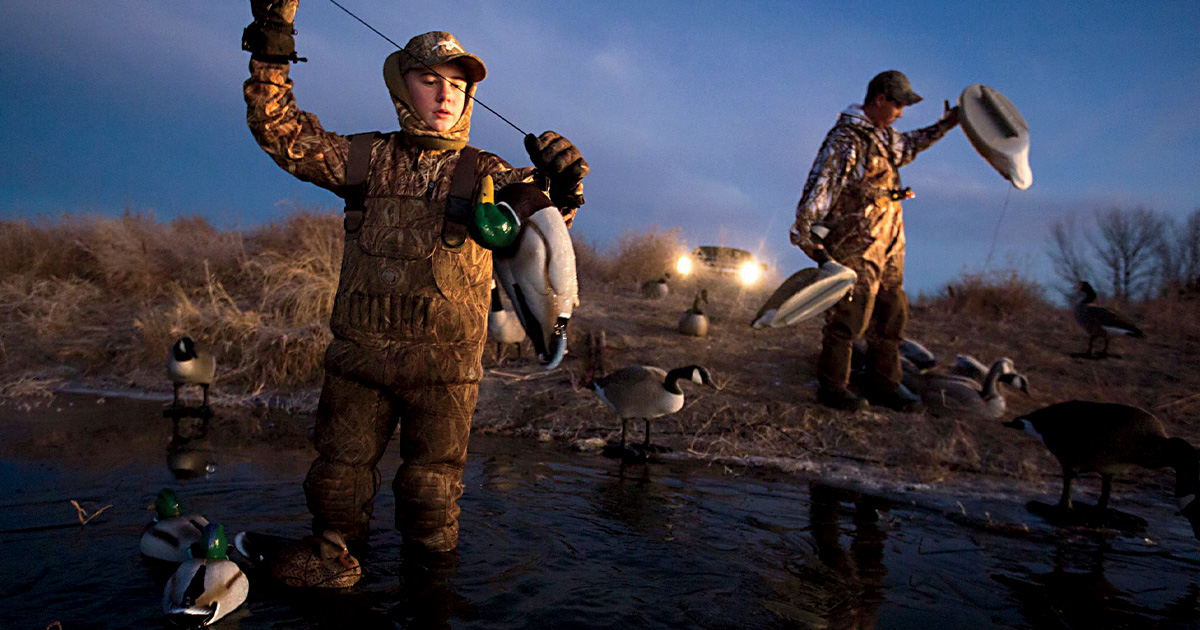
This may be the simplest decoy spread of them all, but it works. The basic technique is to throw out one group of decoys to the left of the blind and another to the right, with a landing zone for the ducks right in the middle.
“This is the spread I hunted over every day with my grandpa down on the Platte River in Nebraska,” says South Dakota hunter Ben Fujan. “And almost without fail, those birds that worked us would land right in front of us, right between the two groups of decoys.”
The distance to the farthest edge of the decoy spread can be adjusted if ducks are landing outside of shooting range, Fujan adds, and motion decoys can be moved to one side or the other if ducks are sliding to an outside edge of the spread.
“The cool thing is that it really works with any number of decoys. You can go big or you can go small, based on where you’re hunting or how many decoys you have,” Fujan says. “I’ve even taken it a step further and used just one group of decoys right in front of the blind on small-water hunts in recent years. Nothing fancy but it kills ducks.”
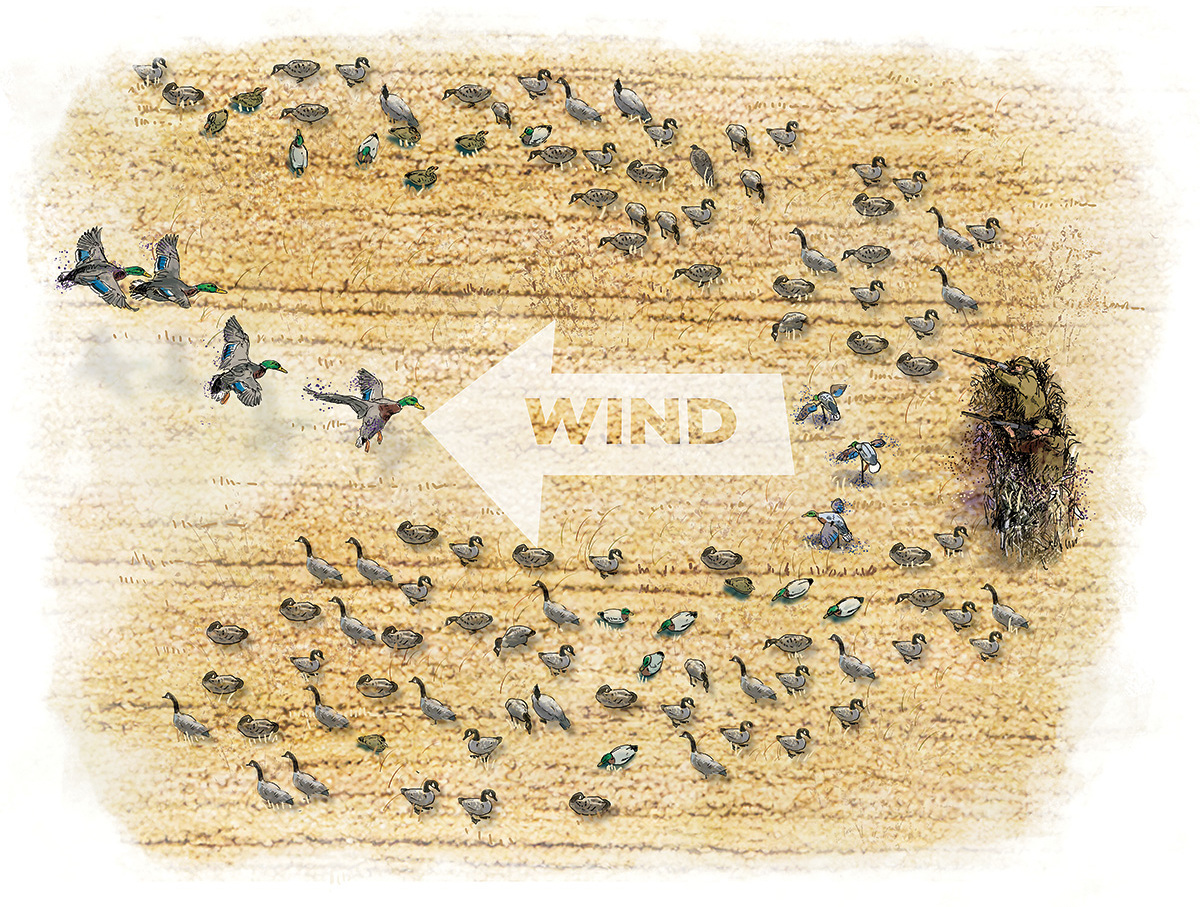
The horseshoe spread can be effective for a variety of waterfowl species over water and on land, but for hunters who enjoy decoying mallards in harvested fields of corn, beans, peas, wheat, or other crops, this U-shaped pattern becomes the lucky charm for putting flocks of greenheads in the hole.
There is no limit to the number of decoys that a hunter can use in this spread, and it works equally well with full-bodies, shells, silhouettes, or a combination. Many horseshoe spreads consist of goose decoys only, but if you add some spinning-wing motion decoys to the shooting hole, you can bring in ducks too. Full-body or silhouette duck decoys can also be scattered along either arm of the spread, with the bulk placed along the edge of the goose decoys at the base of the U.
“With this spread, you can keep your blinds at the base of the horseshoe so birds are decoying straight to you. But if keeping the wind at your back puts the sun in your eyes, you can slide the blinds to either side of the spread to create a crossing shot, which I think is a great angle,” explains Trevor Manteufel, owner and guide at Top of the Flyway Outfitters in Peace River, Alberta. “One major upgrade you can make is to have remotes on your motion decoys if you are also hunting geese. Canada geese seem to slide or flare when the wings are spinning, so when those big birds are working the decoys, press the button on that remote and turn the spinners off until the next bunch of mallards decides to give you a look.”
Ducks Unlimited uses cookies to enhance your browsing experience, optimize site functionality, analyze traffic, and deliver personalized advertising through third parties. By continuing to use this site, you agree to our use of cookies. View Privacy Policy